
Am Fam Physician. 2017;96(4):240-247
Related editorial: The CDC's STEADI Initiative: Promoting Older Adult Health and Independence Through Fall Prevention
Patient information: See related handout on tips for preventing falls, written by the authors of this article.
Author disclosure: No relevant financial affiliations.
The American Geriatrics Society and British Geriatrics Society recommend that all adults older than 65 years be screened annually for a history of falls or balance impairment. The U.S. Preventive Services Task Force and American Academy of Family Physicians recommend exercise or physical therapy and vitamin D supplementation to prevent falls in community-dwelling older adults who are at increased risk of falls. Although the U.S. Preventive Services Task Force and American Academy of Family Physicians do not recommend routine multifactorial intervention to prevent falls in all community-dwelling older adults, they state that it may be appropriate in individual cases. The Centers for Disease Control and Prevention developed an algorithm to aid in the implementation of the American Geriatrics Society/British Geriatrics Society guideline. The algorithm suggests assessment and multifactorial intervention for those who have had two or more falls or one fall-related injury. Multifactorial interventions should include exercise, particularly balance, strength, and gait training; vitamin D supplementation with or without calcium; management of medications, especially psychoactive medications; home environment modification; and management of postural hypotension, vision problems, foot problems, and footwear. These interventions effectively decrease falls in the community, hospital, and nursing home settings. Fall prevention is reimbursed as part of the Medicare Annual Wellness Visit.
Falls are the leading cause of fatal and nonfatal injuries in persons older than 65 years.1 In a survey, 37.5% of fallers responded that they required medical treatment or activity restriction.2 Fall injuries result in 2.8 million emergency department visits annually,1 and 25% of falls cause serious injuries, such as fractures or traumatic brain injury.3 The risk of falls and resulting serious injury increases with age. Injuries, such as hip fracture, and falls are risk factors for placement in a nursing home,4 where the fall risk is nearly three times that of persons living in the community.5 A history of falls is associated with a two- to sixfold increased risk of a future fall.6 Noninjurious falls are a harbinger of potentially life-threatening events and are an opportunity for physicians to intervene.
| Clinical recommendation | Evidence rating | References | |
|---|---|---|---|
| Community-dwelling older persons at low to moderate risk of falls should participate in an exercise program or physical therapy and take vitamin D supplements. | B | 7, 8, 20, 23, 29 | |
| Community-dwelling older persons at high risk of falls should receive a multifactorial risk assessment and intervention tailored to their needs. | C | 8, 20, 23 | |
| Older persons at risk of falls who are hospitalized in an acute setting or for an extended time in a subacute setting should receive a multifactorial risk assessment and intervention tailored to their needs. | B | 21, 38, 39, 42 | |
| Nursing home residents at risk of falls should receive a multifactorial risk assessment and intervention tailored to their needs that are administered by a multidisciplinary team. | B | 22 | |
| The following components should be included in multifactorial interventions for falls in older persons: | |||
| Exercise, particularly balance, strength, and gait training | A | 7, 8, 22 | |
| Vitamin D3 supplementation of at least 800 IU daily | B | 7, 8, 29 | |
| Withdrawal or minimization of psychoactive and other medications | B | 7, 8, 22, 39 | |
| Adaptation or modification of the home environment for those who have fallen or have visual impairment | B | 7, 8, 22 | |
| Management of foot problems and footwear | B | 7, 8, 22, 39 | |
| Management of postural hypotension | B | 7, 8, 22 | |
| Dual chamber cardiac pacing should be considered in patients with carotid sinus hypersensitivity who experience unexplained recurrent falls. | B | 6, 20, 37 | |
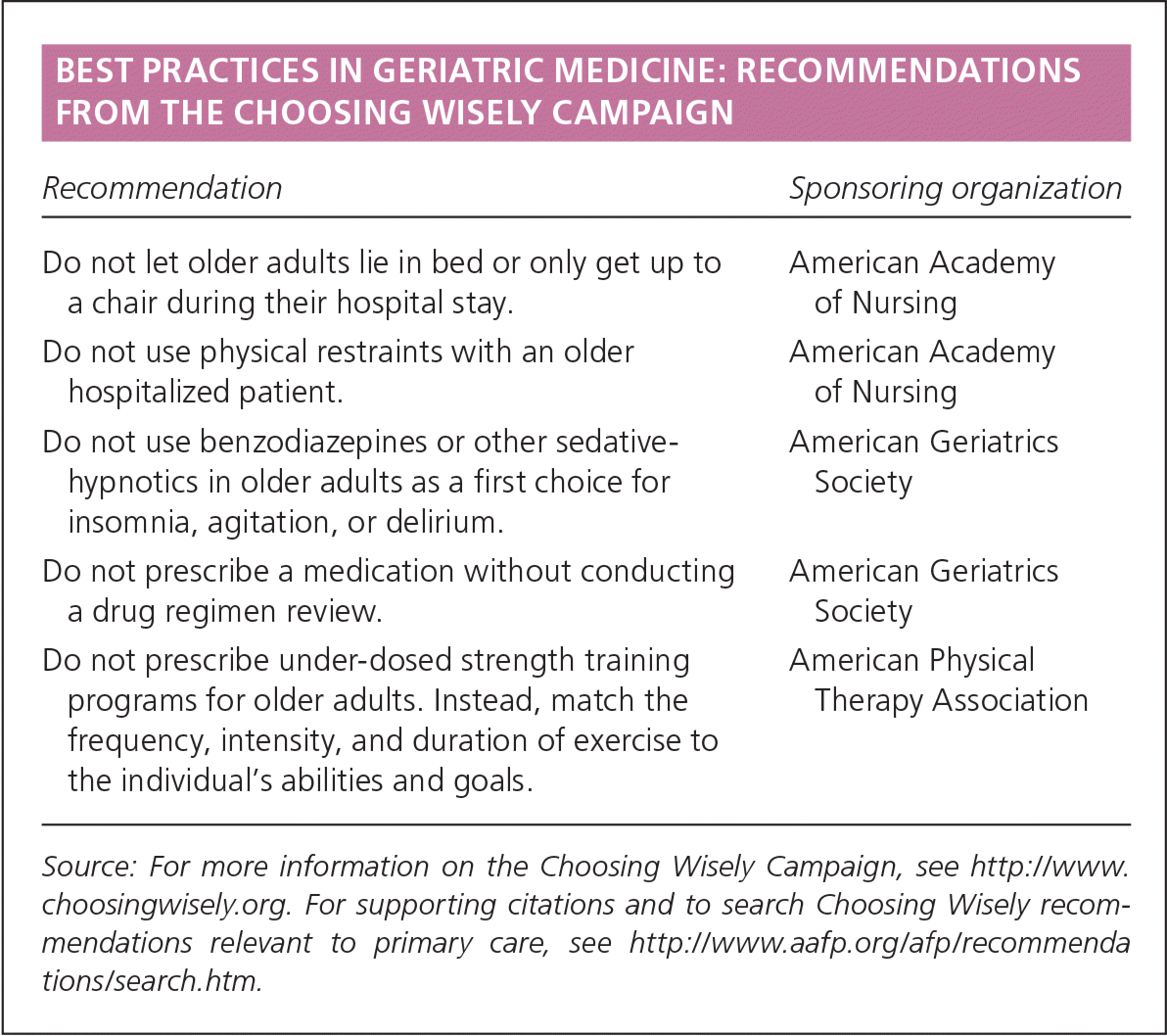
| Recommendation | Sponsoring organization |
|---|---|
| Do not let older adults lie in bed or only get up to a chair during their hospital stay. | American Academy of Nursing |
| Do not use physical restraints with an older hospitalized patient. | American Academy of Nursing |
| Do not use benzodiazepines or other sedative-hypnotics in older adults as a first choice for insomnia, agitation, or delirium. | American Geriatrics Society |
| Do not prescribe a medication without conducting a drug regimen review. | American Geriatrics Society |
| Do not prescribe under-dosed strength training programs for older adults. Instead, match the frequency, intensity, and duration of exercise to the individual's abilities and goals. | American Physical Therapy Association |
Many of the recommendations in this article are based on the American Geriatrics Society/British Geriatrics Society (AGS/BGS) clinical practice guideline for the prevention of falls in older persons.7 The Centers for Disease Control and Prevention (CDC) developed the Stopping Elderly Accidents, Deaths, and Injuries (STEADI) toolkit for physicians based on the AGS/BGS guideline.8 The tool-kit includes resources such as an algorithm for fall risk assessment and interventions (Figure 19 ) and the Stages of Change Model (Table 110 ). Fall prevention is reimbursed as part of the Medicare Annual Wellness Visit.
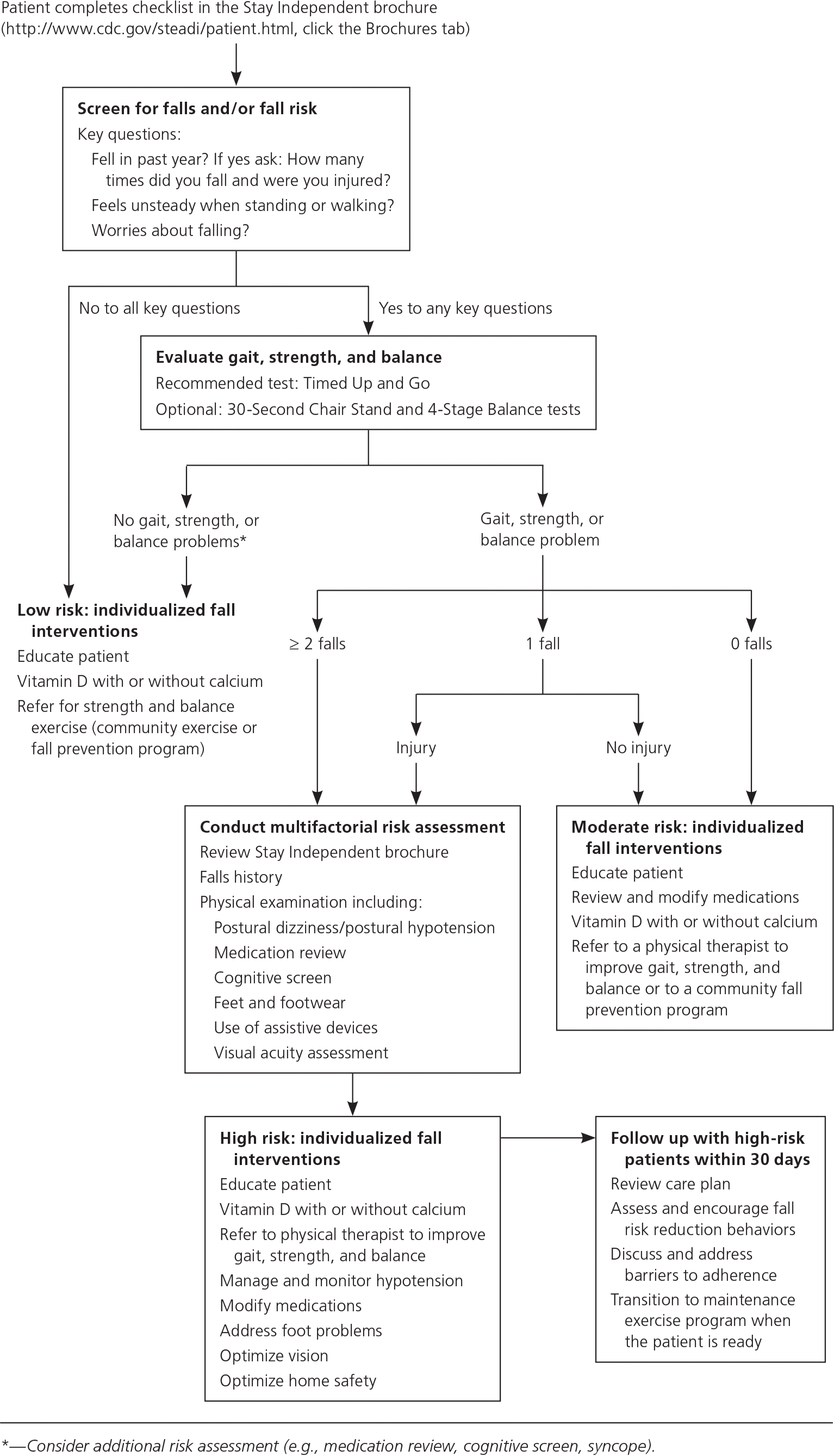
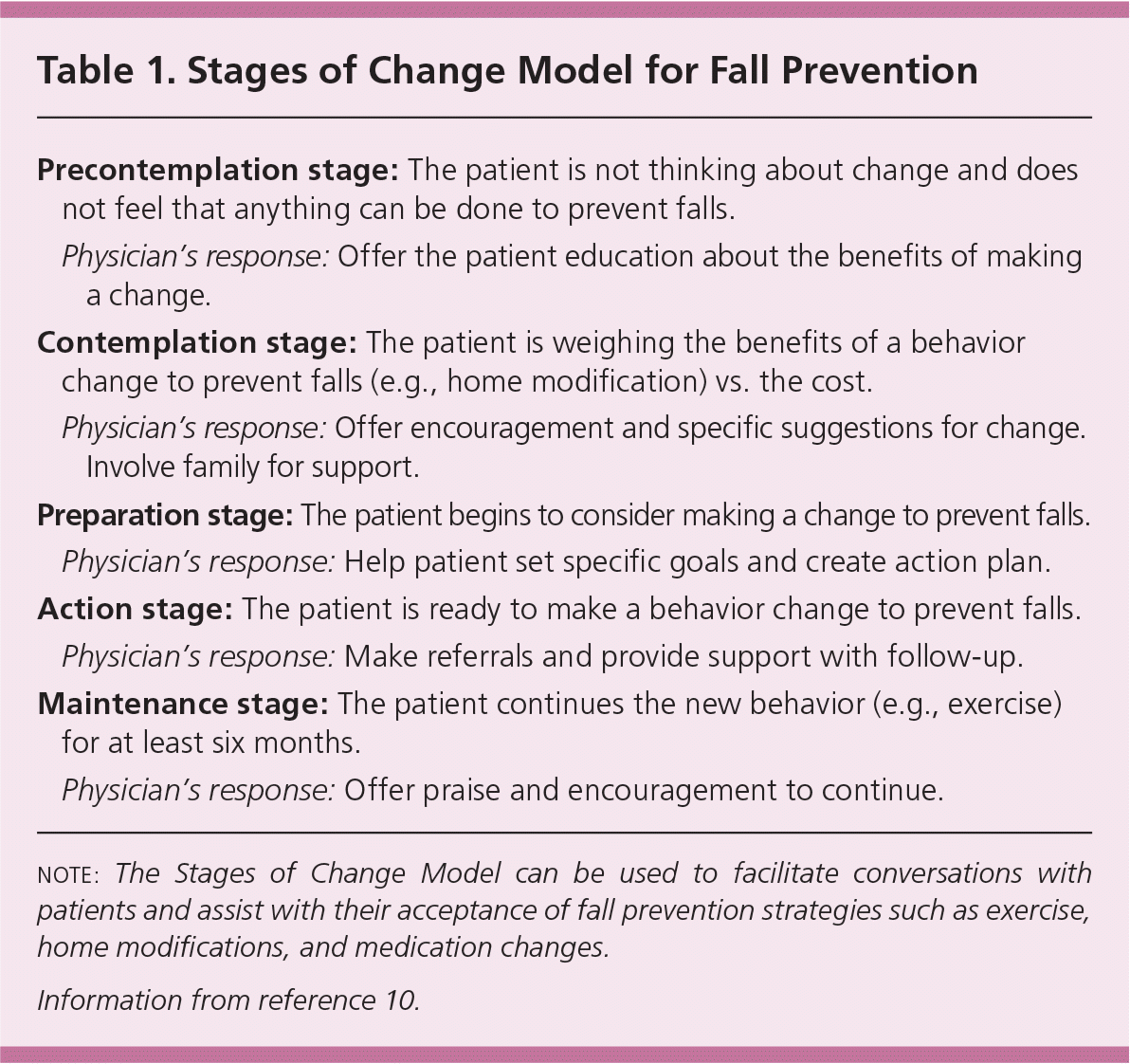
| Precontemplation stage: The patient is not thinking about change and does not feel that anything can be done to prevent falls. | |
| Physician's response: Offer the patient education about the benefits of making a change. | |
| Contemplation stage: The patient is weighing the benefits of a behavior change to prevent falls (e.g., home modification) vs. the cost. | |
| Physician's response: Offer encouragement and specific suggestions for change. Involve family for support. | |
| Preparation stage: The patient begins to consider making a change to prevent falls. | |
| Physician's response: Help patient set specific goals and create action plan. | |
| Action stage: The patient is ready to make a behavior change to prevent falls. | |
| Physician's response: Make referrals and provide support with follow-up. | |
| Maintenance stage: The patient continues the new behavior (e.g., exercise) for at least six months. | |
| Physician's response: Offer praise and encouragement to continue. | |
Risk Factors
There are many risk factors for falls, some of which are modifiable (Table 2).6,11–16 The strongest modifiable risk factors are balance impairment, gait impairment, muscle weakness, and medication use. Fear of falling can result in a downward cascade of events leading to social isolation and loss of function, as well as more falls.17 Approximately 60% of falls are the result of multiple factors.18
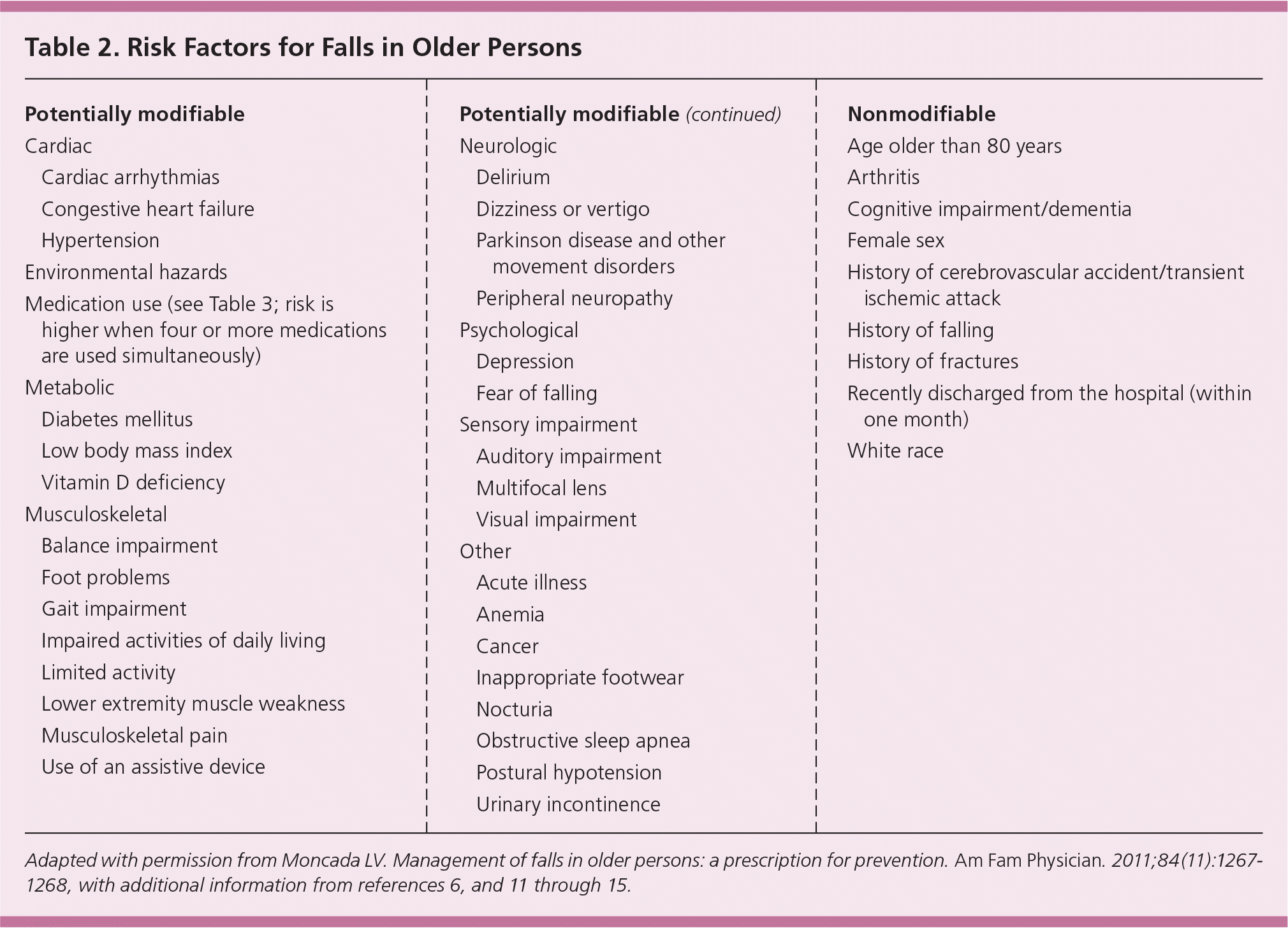
| Potentially modifiable | |||
|---|---|---|---|
| Cardiac | |||
| Cardiac arrhythmias | |||
| Congestive heart failure | |||
| Hypertension | |||
| Environmental hazards | |||
| Medication use (see Table 3; risk is higher when four or more medications are used simultaneously) | |||
| Metabolic | |||
| Diabetes mellitus | |||
| Low body mass index | |||
| Vitamin D deficiency | |||
| Musculoskeletal | |||
| Balance impairment | |||
| Foot problems | |||
| Gait impairment | |||
| Impaired activities of daily living | |||
| Limited activity | |||
| Lower extremity muscle weakness | |||
| Musculoskeletal pain | |||
| Use of an assistive device | |||
| Neurologic | |||
| Delirium | |||
| Dizziness or vertigo | |||
| Parkinson disease and other movement disorders | |||
| Peripheral neuropathy | |||
| Psychological | |||
| Depression | |||
| Fear of falling | |||
| Sensory impairment | |||
| Auditory impairment | |||
| Multifocal lens | |||
| Visual impairment | |||
| Other | |||
| Acute illness | |||
| Anemia | |||
| Cancer | |||
| Inappropriate footwear | |||
| Nocturia | |||
| Obstructive sleep apnea | |||
| Postural hypotension | |||
| Urinary incontinence | |||
| Nonmodifiable | |||
| Age older than 80 years | |||
| Arthritis | |||
| Cognitive impairment/dementia | |||
| Female sex | |||
| History of cerebrovascular accident/transient ischemic attack | |||
| History of falling | |||
| History of fractures | |||
| Recently discharged from the hospital (within one month) | |||
| White race | |||
Assessment
All persons older than 65 years should be asked annually about whether they have fallen, the number of falls they have had and if they caused injury, and whether they have difficulty with walking or balance.7 The CDC STEADI initiative encourages physicians to screen for fall risk by asking these questions and about fear of falling, or by administering the Stay Independent self–risk assessment brochure.8 It is important for physicians to elicit a falls history because, in one study, only 36% of men and 50% of women who fell in the previous year talked to their physician about falls.19 A gait, strength, and balance evaluation should be performed if a patient answers positively to any of the screening questions. The Timed Up and Go (TUG) test, 30-Second Chair Stand test, and 4-Stage Balance test are quick and easy to administer. These tests are shown in online instructional videos at https://www.youtube.com/playlist?list=PLWqeMoseZ2MwwznjB-TFrq4dtHX8hPsSE. The TUG test is recommended as the primary measure of functional assessment. It involves timing the patient as he or she rises from a chair with armrests, walks 10 feet (with an assistive device if applicable), turns, walks back to the chair, and sits.8
A multifactorial fall risk assessment should be performed for all high-risk persons who require 12 or more seconds to complete the TUG test and report two or more falls or one fall-related injury.8,9 The assessment should include circumstances and frequency of falls, associated symptoms, injuries, medications (prescription and over-the-counter), other relevant acute or chronic medical problems, activities of daily living and use of assistive devices, and fear of falling.7 The physical examination should include evaluation of muscle strength; cognitive examination; cardiovascular examination, including postural dizziness/postural hypotension; assessment of visual acuity; and examination of the feet and footwear.7 An environmental assessment, including home safety, is also recommended.7 Checklists for home safety and risk factors for falling (Stay Independent brochure) are available at http://www.cdc.gov/steadi/patient.html (click the Brochures tab). Any person seeking medical attention immediately after a fall should be evaluated for underlying acute illness.
Multifactorial vs. Single Interventions
In each setting (community, hospital, and nursing home), assessment with corresponding individualized multifactorial intervention involving a combination of components (e.g., exercise, medication reduction) reduces fall rates.20–22 Studies vary widely on which components were used. Single interventions such as exercise alone are also effective (without a complete multifactorial assessment) in falls prevention.20
Community Setting
MULTIFACTORIAL INTERVENTIONS
The U.S. Preventive Services Task Force (USPSTF) and American Academy of Family Physicians do not recommend routine multifactorial intervention in all community-dwelling older adults at risk of falling, but they state that multifactorial assessment and management may be appropriate in individual cases.23,24 The CDC advises that moderate-risk patients (those with gait, strength, or balance impairment and a history of zero or one noninjurious fall) receive vitamin D supplementation with or without calcium, a medication review, and a referral to physical therapy or a community fall prevention program.9
High-risk patients should receive a multifactorial intervention, including an exercise program with muscle strengthening and gait and balance training; vitamin D supplementation with or without calcium; management of medications; home environment modification; and management of postural hypotension, vision problems, foot problems, and footwear.7 These patients should follow up within 30 days. A Cochrane review concluded that assessment and multifactorial interventions in community-dwelling older adults reduce the number of falls by 24%.20 These strategies can also reduce hip and other fractures, head injuries, use of medical services related to falls,25 and death.26
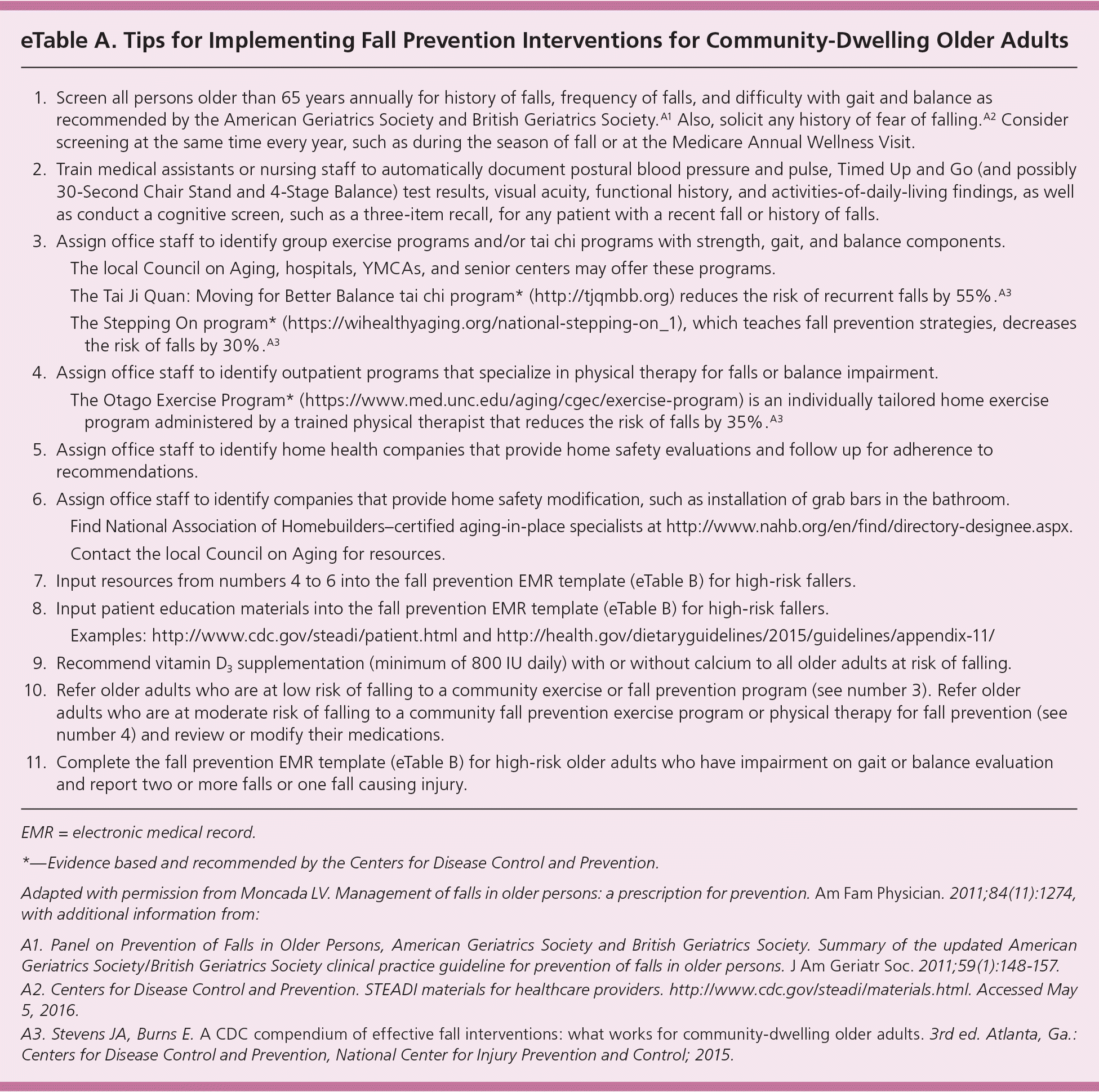
| 1. | Screen all persons older than 65 years annually for history of falls, frequency of falls, and difficulty with gait and balance as recommended by the American Geriatrics Society and British Geriatrics Society.A1 Also, solicit any history of fear of falling.A2 Consider screening at the same time every year, such as during the season of fall or at the Medicare Annual Wellness Visit. |
| 2. | Train medical assistants or nursing staff to automatically document postural blood pressure and pulse, Timed Up and Go (and possibly 30-Second Chair Stand and 4-Stage Balance) test results, visual acuity, functional history, and activities-of-daily-living findings, as well as conduct a cognitive screen, such as a three-item recall, for any patient with a recent fall or history of falls. |
| 3. | Assign office staff to identify group exercise programs and/or tai chi programs with strength, gait, and balance components. |
| The local Council on Aging, hospitals, YMCAs, and senior centers may offer these programs. | |
| The Tai Ji Quan: Moving for Better Balance tai chi program* (http://tjqmbb.org) reduces the risk of recurrent falls by 55%.A3 | |
| The Stepping On program* (https://wihealthyaging.org/national-stepping-on_1), which teaches fall prevention strategies, decreases the risk of falls by 30%.A3 | |
| 4. | Assign office staff to identify outpatient programs that specialize in physical therapy for falls or balance impairment. |
| The Otago Exercise Program* (https://www.med.unc.edu/aging/cgec/exercise-program) is an individually tailored home exercise program administered by a trained physical therapist that reduces the risk of falls by 35%.A3 | |
| 5. | Assign office staff to identify home health companies that provide home safety evaluations and follow up for adherence to recommendations. |
| 6. | Assign office staff to identify companies that provide home safety modification, such as installation of grab bars in the bathroom. |
| Find National Association of Homebuilders–certified aging-in-place specialists at http://www.nahb.org/en/find/directory-designee.aspx. | |
| Contact the local Council on Aging for resources. | |
| 7. | Input resources from numbers 4 to 6 into the fall prevention EMR template (eTable B) for high-risk fallers. |
| 8. | Input patient education materials into the fall prevention EMR template (eTable B) for high-risk fallers. |
| Examples: http://www.cdc.gov/steadi/patient.html and http://health.gov/dietaryguidelines/2015/guidelines/appendix-11/ | |
| 9. | Recommend vitamin D3 supplementation (minimum of 800 IU daily) with or without calcium to all older adults at risk of falling. |
| 10. | Refer older adults who are at low risk of falling to a community exercise or fall prevention program (see number 3). Refer older adults who are at moderate risk of falling to a community fall prevention exercise program or physical therapy for fall prevention (see number 4) and review or modify their medications. |
| 11. | Complete the fall prevention EMR template (eTable B) for high-risk older adults who have impairment on gait or balance evaluation and report two or more falls or one fall causing injury. |

| Chief problem | ||||||
| History of a fall | ||||||
| History | ||||||
| Number of falls in the past year | ||||||
| Feeling of unsteadiness when standing or walking | ||||||
| Fear of falling | ||||||
| Injuries due to a fall | ||||||
| Environmental hazards | ||||||
| Dizziness | ||||||
| Syncope | ||||||
| Assistive devices needed | ||||||
| Assistive device used at the time of the fall | ||||||
| Assistance needed with transferring, bathing, dressing, or toileting | ||||||
| Review of systems | ||||||
| Vision problems | ||||||
| Date of the most recent eye examination by an ophthalmologist or optometrist | ||||||
| Urinary or fecal incontinence | ||||||
| Acute or chronic musculoskeletal problems | ||||||
| History of osteoporosis | ||||||
| Foot pain | ||||||
| Footwear worn at the time of the fall | ||||||
| Acute or chronic neurologic problems | ||||||
| History of acute or chronic cognitive impairment | ||||||
| Medications | ||||||
| Current medications, including over-the-counter, herbal, and psychoactive medications | ||||||
| New medications or recent dosage changes | ||||||
| Social history | ||||||
| History of alcohol use | ||||||
| Physical examination | ||||||
| Visual acuity | ||||||
| Left eye with glasses | ||||||
| Right eye with glasses | ||||||
| Bilateral eyes with glasses | ||||||
| Use of multifocal glasses | ||||||
| Postural blood pressure and pulse | ||||||
| Cardiovascular examination | ||||||
| Musculoskeletal strength | ||||||
| Gait and use of assistive device | ||||||
| Number of seconds for Timed Up and Go test with assistive device (12 or more seconds indicates a high risk of falling) | ||||||
| 4-Stage Balance test (inability to hold first three stages for 10 seconds or more without assistive device indicates increased risk of falling) | ||||||
| Number of seconds with feet side by side | ||||||
| Number of seconds in semitandem stance | ||||||
| Number of seconds in tandem stance | ||||||
| Number of seconds standing on one foot | ||||||
| Number of stands in 30-Second Chair Stand test | ||||||
| Below-average scores (number of stands) by age and sex: | ||||||
| 60 to 64 years: < 14 men, < 12 women | ||||||
| 65 to 69 years: < 12 men, < 11 women | ||||||
| 70 to 74 years: < 12 men, < 10 women | ||||||
| 75 to 79 years: < 11 men, < 10 women | ||||||
| 80 to 84 years: < 10 men, < 9 women | ||||||
| 85 to 89 years: < 8 men and women | ||||||
| Feet examination | ||||||
| Footwear | ||||||
| Neurologic examination | ||||||
| Cognitive examination (number of items recalled at three minutes) | ||||||
| Assessment | ||||||
| ICD-10 codes | ||||||
| R26.2 for difficulty in walking, not elsewhere classified | ||||||
| R26.81 for unsteadiness on feet | ||||||
| R29.6 for repeated falls | ||||||
| Z91.81 for history of falling | ||||||
| Plan for those at high risk of falling | ||||||
| Referral to a physical therapist for gait, strength, and balance training | ||||||
| Vitamin D3 supplementation (minimum of 800 IU daily) with or without calcium | ||||||
| List of how medications were reviewed and modified | ||||||
| Referral to occupational therapist for home safety evaluation | ||||||
| Postural hypotension treatment | ||||||
| Referral to ophthalmologist or optometrist | ||||||
| Advice to wear single lens glasses for outdoor activities, walking, or climbing stairs | ||||||
| Referral to a podiatrist | ||||||
| Recommendation to wear footwear with a low heel and high surface contact area | ||||||
| Bone density scan (dual energy x-ray absorptiometry) | ||||||
| 25-hydroxyvitamin D measurement | ||||||
| Osteoporosis treatment | ||||||
| Personal emergency response system | ||||||
| Complete blood count, chemistry panel, urinalysis, or chest radiography (if patient may have underlying acute or subacute illness) | ||||||
| List of patient education materials distributed (e.g., http://www.cdc.gov/steadi/patient.html, http://health.gov/dietaryguidelines/2015/guidelines/appendix-11/) | ||||||
| Follow-up visit scheduled for one month to encourage fall risk reduction behaviors, assess adherence, and address any barriers to the care plan | ||||||
SINGLE INTERVENTIONS
Exercise or Physical Therapy. The USPSTF and the American Academy of Family Physicians conclude that exercise or physical therapy alone has moderate net benefit in preventing falls.23,24 All older adults who are at risk of falling should be offered physical therapy or an exercise program incorporating balance, gait, and strength training.7 A Cochrane review found that the number of fallers was reduced by 15% to 29% with group exercise containing multiple components, individual home-based exercise, or tai chi.20 In most studies, the exercise program was a minimum of 12 weeks with 30- to 90-minute sessions one to three times per week.20 In a meta-analysis, fall prevention exercise programs reduced falls resulting in fracture by 61% and reduced falls resulting in the need for medical care by 43%.27 Exercise interventions have also been effective in reducing the fall rate in cognitively impaired older adults.28
Vitamin D. The evidence supporting vitamin D supplementation to reduce the risk of falls in community-dwelling adults is mixed. Although the USPSTF, American Academy of Family Physicians, and AGS recommend vitamin D, a Cochrane review did not find benefit.20,23,24,29 The USPSTF recommends vitamin D supplementation in older adults at increased fall risk.23 The recommended dietary allowance of vitamin D is 800 IU per day 30; however, the AGS recommends vitamin D3 plus calcium supplements that include at least 1,000 IU of vitamin D per day for older persons to reduce fall risk.29
Medication Review. Patients and caregivers must be educated about increased fall risk with polypharmacy and certain medications, especially benzodiazepines, opioids, and sleep medications (Table 311,31 ). In one study, withdrawal of psychotropics reduced the fall rate by 66%.32 Another study showed that educating family physicians about their prescribing practices can reduce falls by 39%.33 When possible, physicians should limit high-risk medications and the total number of medications used. Any medication that was initiated or increased shortly before a fall should be considered a possible cause.
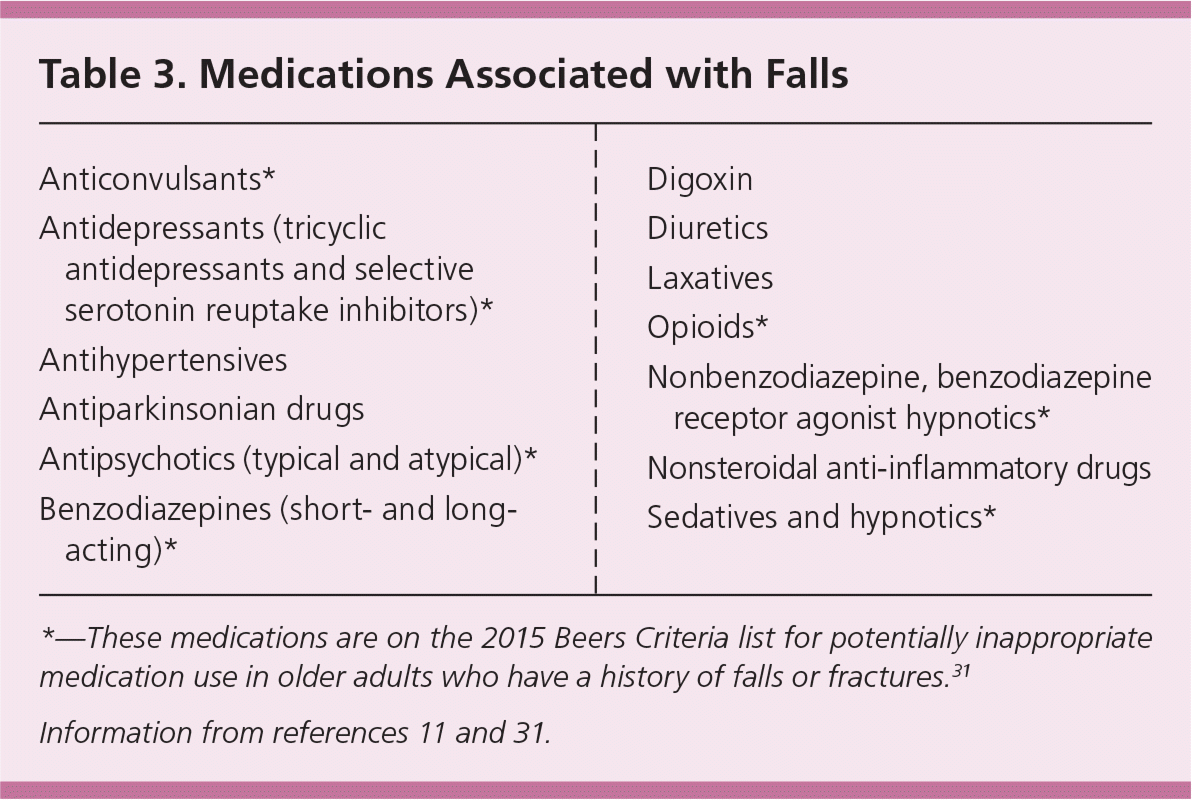
| Anticonvulsants* |
| Antidepressants (tricyclic antidepressants and selective serotonin reuptake inhibitors)* |
| Antihypertensives |
| Antiparkinsonian drugs |
| Antipsychotics (typical and atypical)* |
| Benzodiazepines (short- and long-acting)* |
| Digoxin |
| Diuretics |
| Laxatives |
| Opioids* |
| Nonbenzodiazepine, benzodiazepine receptor agonist hypnotics* |
| Nonsteroidal anti-inflammatory drugs |
| Sedatives and hypnotics* |
Home Safety. The physician should monitor progress toward improving home safety,7 which may be done with the assistance of a home health agency. Training patients about proper use of assistive devices for mobility is an important part of improving safety. Home safety modification interventions reduce falls and are most effective in patients who have a high risk of falls or who have severe visual impairment and when delivered by an occupational therapist.20
Vision Correction. Falls are reduced when regular wearers of multifocal glasses who routinely participate in outdoor activities are given single lens glasses.34 Patients who use multifocal glasses may benefit from wearing single lens glasses for activities such as walking or climbing stairs. The risk of injurious falls increases after a first-eye cataract surgery. Second-eye cataract surgery decreases fall risk, although fall risk remains above baseline.35 Delays in second-eye cataract surgery should be minimized.
Foot Care. Podiatry intervention involving routine podiatry care, home-based foot and ankle exercises, foot orthoses, and advice about footwear reduces the fall rate in community-dwelling older adults with disabling foot pain.36 Older persons should be advised that walking in shoes with low heels and a high surface contact area may reduce the risk of falls.7
Hospital Setting
MULTIFACTORIAL INTERVENTIONS
Multifactorial interventions have been effective in the extended-care and rehabilitation hospital settings.21 A systematic review suggested that multicomponent interventions may also reduce fall rates in U.S. acute care hospitals, but the pooled risk reduction was not statistically significant.38 This review included several successful individual trials in which fall risk was reduced by up to 30%. Components included a standardized assessment to identify risk factors, such as delirium, for which patient-specific care plans could be developed; patient and staff education; alert signs; safety and toileting rounds; bed and chair alarms; footwear advice; and medication review.38,39 There is little evidence that low beds and bed alarms reduce falls.40 Improved bed alarms and wearable movement sensors are currently being developed, but the evidence for their ability to prevent falls is inconsistent.41
The Agency for Healthcare Research and Quality has developed a toolkit to assist in the implementation of interdisciplinary best practices for fall prevention in hospitals (available at http://www.ahrq.gov/sites/default/files/publications/files/fallpxtoolkit_0.pdf).42 The Centers for Medicare and Medicaid Services has designated falls occurring during hospitalization as preventable; therefore, any additional cost of care or increased length of stay because of resulting fracture or brain injury is the hospital's responsibility. Physicians must be diligent about avoiding restraints whenever possible because they increase the risk of injurious falls.43
SINGLE INTERVENTIONS
Although data are limited, supervised exercise in the extended-care hospital setting has been shown to decrease fall risk.21
Nursing Home Setting
MULTIFACTORIAL INTERVENTIONS
Multidisciplinary team administration of multifactorial assessment and intervention in nursing homes reduces falls by 33% and the number of recurrent fallers by 21%.22 The individualized interventions contained many similar components to the interventions provided for community-dwelling persons but also included staff education. Falls and fall-related injuries were not increased when nursing homes implemented interventions to reduce the use of restraints such as belts and full-enclosure bed rails.44
SINGLE INTERVENTIONS
Exercise. The effectiveness of exercise programs in long-term care is controversial.21,22 A meta-analysis concluded that exercise intervention to prevent falls is most effective if balance exercise is combined with other types of exercise, usually resistance training, and performed two to three times per week for more than six months.45 Exercise interventions have demonstrated effectiveness in preventing falls in cognitively impaired older adults who are in the nursing home settings.28
Vitamin D. Vitamin D supplementation decreases the number of falls in long-term care residents.21 The Institute of Medicine recommends that persons older than 70 years (including those who are institutionalized) receive 800 IU of vitamin D3 daily,30 and the AGS recommends at least 1,000 IU of vitamin D3 daily.29
Interventions to Reduce Fall-Related Injuries
Bisphosphonates are recommended for patients with osteoporosis to reduce fractures from falls.46 A Cochrane review found that vitamin D plus calcium supplementation resulted in nine fewer hip fractures per 1,000 institutionalized older adults per year,47 but the USPSTF concludes that the evidence is insufficient for the use of vitamin D for the primary prevention of fractures in noninstitutionalized adults.48 Hip protectors may reduce hip fractures but may also slightly increase the risk of pelvic fractures.49
New sensors, such as wristwatches, cameras, microphones, and floor sensors, are being developed to detect falls quickly in various settings, but trials have been small and inconclusive.50 Personal emergency response systems decrease hospitalization and may be considered for community-dwelling older adults.51
Data Sources: An Ovid Medline search was completed using the term accidental falls. The search included meta-analyses, randomized controlled trials, clinical trials, and reviews. Also searched were the Agency for Healthcare Research and Quality evidence reports, the Cochrane database, the National Guideline Clearinghouse database, the U.S. Preventive Services Task Force website, and Essential Evidence Plus. Search dates: March 30, 2016, and December 6, 2016.
